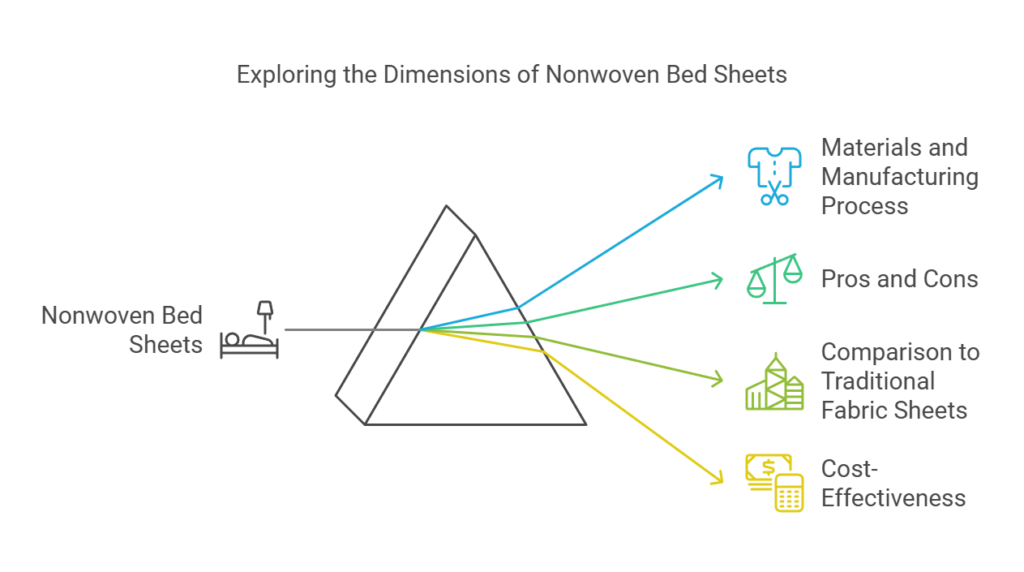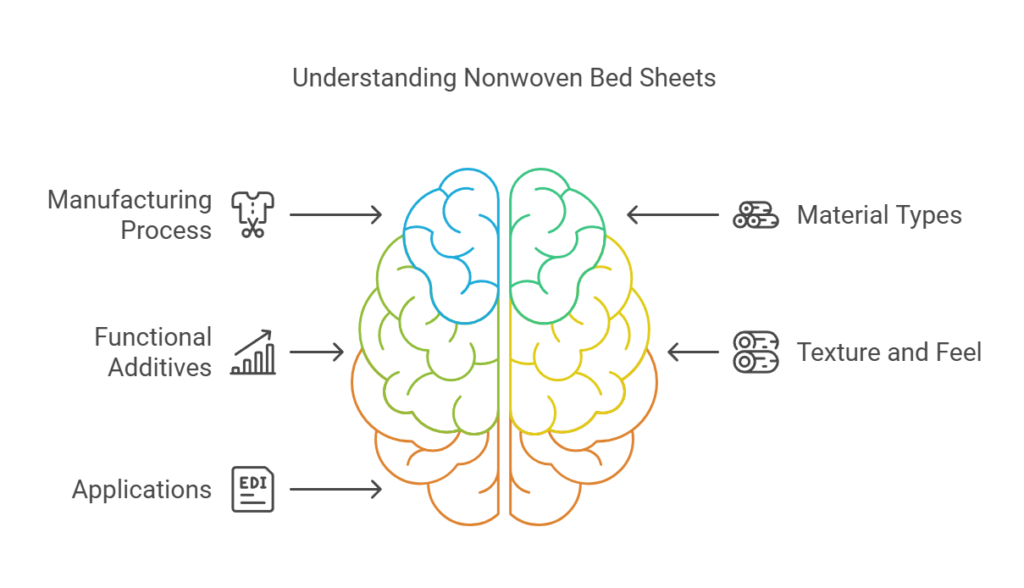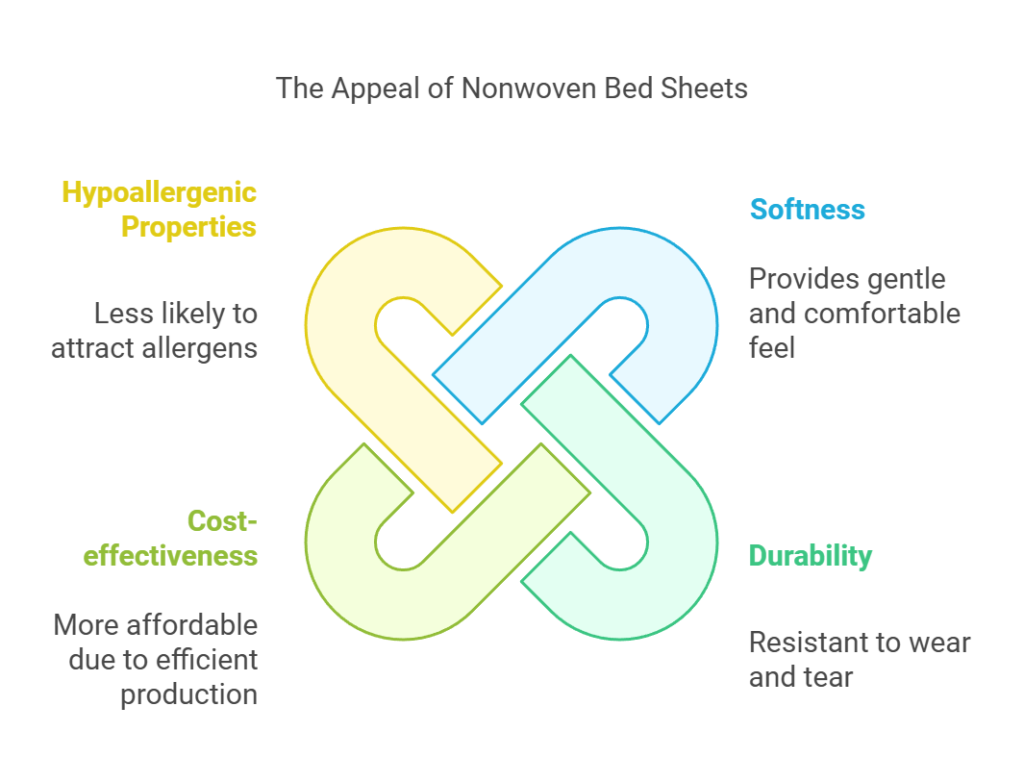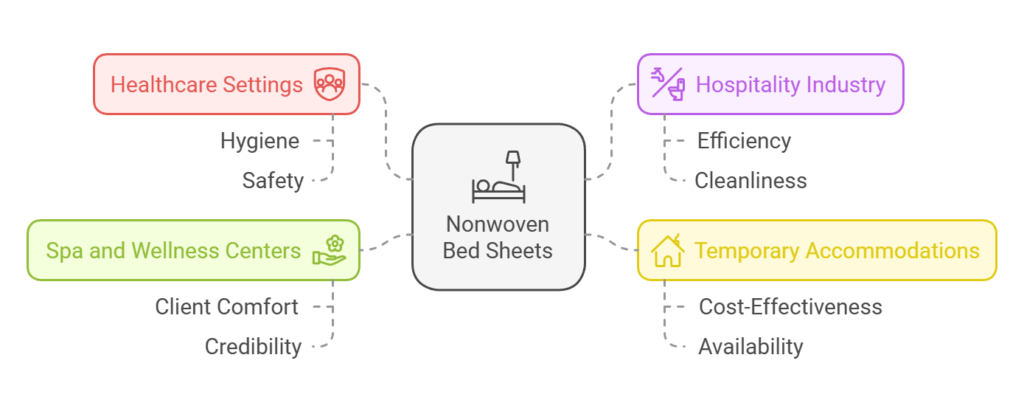Introduction
In a world increasingly focused on convenience, efficiency, and sustainability, nonwoven bed sheets have emerged as a compelling alternative to traditional fabric sheets. Crafted through a unique manufacturing process that bonds fibers together, nonwoven materials offer distinct advantages and potential drawbacks that merit closer examination. As consumers seek options that align with their lifestyle and environmental considerations, understanding the true value of nonwoven bed sheets becomes essential.

This article aims to delve into the key aspects surrounding nonwoven bed sheets, providing a comprehensive analysis to help you decide if they are worth the investment. We will explore their materials and manufacturing process, weigh their pros and cons, compare them to traditional fabric sheets, and consider their cost-effectiveness. Through this detailed exploration, we hope to answer the core question: Are nonwoven bed sheets worth it? By the end of this discussion, you should have a clearer understanding of whether these innovative sheets meet your specific needs, preferences, and values.
What Are Nonwoven Bed Sheets?
Nonwoven bed sheets are a modern alternative in the realm of bedding textiles. Unlike traditional woven sheets, which are created by interlacing threads in a regular pattern, nonwoven sheets are produced through a process that bonds fibers together without weaving. These fibers can be natural, such as cotton or wool, or synthetic, such as polyester or polypropylene. The key characteristic of nonwoven textiles lies in their method of creation. Various techniques, including heat bonding, chemical bonding, or mechanical entanglement, are employed to create a web of fibers that are then consolidated into a fabric.

One of the unique attributes of nonwoven bed sheets is their inherent versatility. The manufacturing process allows for various functional additives, such as antimicrobial treatments, to be integrated directly into the fabric, offering enhanced properties not commonly found in woven textiles. This results in bed sheets that can be exceptionally durable, water-resistant, or even flame-retardant, depending on the intended application. Moreover, the production of nonwoven fabrics can be highly efficient, allowing for significant cost savings, which can make these sheets an attractive option for both manufacturers and consumers.
In terms of texture and feel, nonwoven bed sheets can vary widely. Advances in technology have enabled the creation of nonwoven textiles that can nearly mimic the softness and breathability of traditional woven cotton sheets. However, they can also be crafted to be exceptionally strong and durable, making them suitable for applications that demand robust materials, such as in healthcare environments or hospitality sectors. Additionally, nonwoven bed sheets often exhibit a greater uniformity and consistency in texture compared to their woven counterparts, due to the controlled manufacturing process.
Overall, nonwoven bed sheets represent a fascinating convergence of innovative textile technology with practical bedding solutions, demonstrating significant deviations from traditional fabric methodologies while offering unique attributes that may appeal to a wide range of users.
Advantages of Nonwoven Bed Sheets
Nonwoven bed sheets have gained popularity for a variety of reasons, primarily due to their unique combination of beneficial features. One of the most significant advantages is their unparalleled softness. Made from fine fibers bonded together, nonwoven materials often result in a fabric that feels gentle and comfortable against the skin, providing a pleasant sleeping experience.

Durability is another noteworthy benefit of nonwoven bed sheets. Unlike traditional woven fabrics that may fray or tear over time, nonwoven materials are constructed through a robust process that enhances their wear and tear resistance. This means nonwoven bed sheets can withstand frequent washing and prolonged use without degrading in quality, ensuring a long-lasting addition to your bedding collection.
Cost-effectiveness is a considerable factor that attracts consumers to nonwoven bed sheets. Their production process tends to be more efficient and less resource-intensive compared to traditional textiles, resulting in a more affordable end product. For budget-conscious individuals and families, this aspect can be a decisive advantage, enabling them to acquire high-quality bed sheets without breaking the bank.
Another significant feature of nonwoven bed sheets is their hypoallergenic properties. For people with allergies or sensitive skin, the choice of bedding material can greatly impact their comfort and health. Nonwoven fabrics are often less likely to attract dust mites and other allergens, making them an excellent option for maintaining a clean and healthy sleeping environment. This hypoallergenic nature helps in reducing skin irritation and respiratory issues, which is crucial for a good night’s sleep.
These features collectively highlight why nonwoven bed sheets are an appealing choice for many consumers. From exceptional softness and durability to affordability and hypoallergenic benefits, nonwoven bed sheets offer a well-rounded package that caters to the essential needs of users, proving to be a worthwhile investment in both comfort and well-being.
Disadvantages of Nonwoven Bed Sheets
When evaluating nonwoven bed sheets, it is crucial to consider their potential drawbacks alongside their advantages. One significant disadvantage is their environmental impact. Nonwoven materials are typically derived from synthetic fibers such as polyester, polypropylene, and polyethylene. These materials are not biodegradable, meaning they contribute to long-term waste accumulation. Furthermore, the production of synthetic fibers is energy-intensive and often relies on non-renewable petroleum resources, further exacerbating environmental concerns.

In terms of longevity, nonwoven bed sheets may not perform as well as their woven counterparts. The unique structure of nonwoven fabrics, characterized by fibers bonded together through mechanical, thermal, or chemical means, tends to be less durable over time. This lack of durability can result in fraying, tearing, or pilling after repeated use and laundering, reducing their overall lifespan compared to traditional woven sheets made from cotton or linen.
Aesthetic appeal is another consideration. Nonwoven bed sheets often lack the smooth, tactile quality of woven fabrics. They might feel rougher or less luxurious, which could be a drawback for those who prioritize a premium sleeping experience. Additionally, nonwoven sheets may not hold colors and patterns as well as woven fabrics, leading to a faded and worn appearance after several washes.
However, it is important to weigh these disadvantages against the advantages previously discussed. While nonwoven bed sheets do have environmental and durability concerns, they commonly offer cost-effectiveness, convenience, and hypoallergenic properties. The balance between these pros and cons will ultimately depend on individual preferences and priorities. By considering both sides, consumers can make an informed decision about whether nonwoven bed sheets meet their specific needs and expectations.
Nonwoven vs. Traditional Woven Sheets
When comparing nonwoven and traditional woven bed sheets, several distinct differences emerge, each influencing the user’s comfort and overall satisfaction. One of the most immediate differences is texture. Traditional woven sheets, often made from materials such as cotton or linen, feature a more robust interlaced structure. This quality can provide a soft and smooth texture that many find appealing. In contrast, nonwoven sheets, constructed from fibers bonded together through chemical, mechanical, or thermal processes, tend to present a slightly different feel. While they may lack the same lush texture as woven fabrics, they often boast a lightweight, airy quality.

Breathability is another crucial factor that sets these two types of sheets apart. Woven sheets have the advantage of tiny gaps between threads that promote airflow, keeping the sleeper cool and comfortable. Nonwoven sheets, however, offer varying degrees of breathability depending on their construction. Modern advancements in nonwoven technology have led to products that are highly breathable and moisture-wicking, although this can vary widely between brands and specific products.
Ease of care is also a paramount concern for many consumers. Traditional woven sheets generally require more attentive maintenance, including specific washing instructions to maintain their quality and longevity. They can be prone to wrinkling and may need ironing to keep a pristine appearance. On the other hand, nonwoven sheets typically offer an advantage in this area. They are often designed to be low-maintenance, resistant to wrinkling, and can be easily cleaned, making them an attractive option for individuals seeking convenience.
Finally, the price point could be a determining factor for many buyers. Traditional woven sheets, especially those of higher quality like Egyptian cotton or high-thread-count variants, can be more expensive due to the intensive manufacturing process and the superior materials used. Nonwoven sheets, meanwhile, are generally more affordable. This cost-effectiveness stems from their diverse composition materials and less labor-intensive production processes.
Taking these differences into account can help consumers make informed decisions based on their specific preferences and requirements. Whether one prioritizes texture, breathability, ease of care, or budget, understanding the distinct attributes of nonwoven and traditional woven bed sheets facilitates a choice that aligns with individual sleeping needs and lifestyle.
Consumer Reviews and Feedback
In evaluating the worth of nonwoven bed sheets, it is essential to consider consumer reviews and feedback. These reviews offer invaluable insights from real-world users, shedding light on the practical benefits and potential drawbacks of this product. Overall, the sentiment appears varied, with users having highlighted both positive and negative aspects.

Many users appreciate nonwoven bed sheets for their cost-effectiveness. Customers frequently commend the reasonable pricing, particularly noting their ability to purchase these sheets in bulk. This makes them an attractive option for situations requiring temporary bedding solutions, such as in healthcare settings or hospitality applications. Consumer feedback often mentions that the affordability does not necessarily compromise quality, with many finding them surprisingly durable given their price point.
Another frequently mentioned advantage is the convenience of nonwoven bed sheets. Reviews indicate that these sheets are maintenance-free, significantly reducing the time and effort required for laundering. This feature is particularly lauded in commercial or emergency uses, where hygiene and prompt turnover of bedding are critical factors.
However, consumer reviews also highlight some common complaints about nonwoven bed sheets. The most recurrent issue is the overall comfort and feel. Users often compare them unfavorably to traditional fabric bed sheets, noting a lack of softness and breathability. Some users find them to be less comfortable, which might impact the quality of sleep. Additionally, there are concerns about their environmental impact, as they are generally single-use products, contributing to increased waste.
In summary, nonwoven bed sheets receive mixed reviews from consumers. While they are praised for their affordability and convenience, there are legitimate concerns regarding comfort and environmental sustainability. Potential buyers should weigh these pros and cons based on their specific needs and priorities.
Best Uses for Nonwoven Bed Sheets
Nonwoven bed sheets have garnered considerable attention for their versatility and practicality across various settings. One of the prime environments where the benefits of nonwoven bed sheets are most evident is hospitals. In medical facilities, hygiene and cleanliness are paramount, and nonwoven bed sheets offer a disposable yet comfortable option. They significantly reduce the risk of cross-contamination, as each patient can sleep on a fresh, sterile surface, thereby enhancing overall patient safety.

Similarly, hotels and short-term accommodations benefit greatly from the use of nonwoven bed sheets. In these establishments, frequent turnover of guests demands quick and efficient linen changes. Nonwoven sheets provide a time-saving solution as they are easy to replace and do not require laundering. This not only boosts operational efficiency but also helps in maintaining high hygiene standards, ensuring guests enjoy a fresh and clean bed with every stay. Furthermore, the lightweight nature of these sheets makes transportation and storage far less cumbersome than traditional linens.
Another vital application of nonwoven bed sheets is within temporary accommodations such as shelters and emergency relief centers. In times of crisis, when large numbers of people require immediate and temporary housing, the practicality of nonwoven sheets becomes indispensable. They are low-cost and widely available, making them an excellent choice for providing comfort and sanitation on a large scale.
In addition to the healthcare and hospitality sectors, nonwoven bed sheets can be employed effectively in settings like spa and wellness centers. These settings necessitate a high turnover of clients, and the use of disposable sheets helps in maintaining a sterile environment, thereby offering clients peace of mind and promoting the establishment’s hygiene credibility.
Overall, the nonwoven bed sheets’ practicality, cost-efficiency, and enhanced hygiene capabilities make them an excellent choice for a multitude of scenarios. These attributes essentially underscore their growing popularity in various professional and temporary accommodations.


27 Responses
Belo blog aqui Além disso, seu site carrega rápido Qual host você está usando Posso obter seu link de afiliado para seu host? Desejo que meu site carregue tão rápido quanto o seu haha
Thank you for your support and recognition – it means a great deal to me. Together, let us continue on this journey of sharing knowledge and wisdom for the betterment of all.
Thank you for the auspicious writeup It in fact was a amusement account it Look advanced to far added agreeable from you However how can we communicate
Thank you for your kind words! I’m glad you enjoyed the write-up. Feel free to reach out through the contact form on our website or via direct message on our social media channels. Looking forward to hearing from you!
Simply Sseven Good post! We will be linking to this particularly great post on our site. Keep up the great writing
Thanks! Glad you liked it. Looking forward to more interactions.
You made various good points there. I did a search on the subject and found a good number of people will have the same opinion with your blog.
Thank you for your comment! Glad to hear that you agree with my points. 😊
I truly appreciate this post. I’ve been looking all over for this! Thank goodness I found it on Bing. You have made my day! Thanks again
Glad you liked the post! 😊
It?¦s in point of fact a nice and helpful piece of info. I?¦m satisfied that you just shared this useful information with us. Please keep us up to date like this. Thanks for sharing.
Thanks! Glad you found it useful. We’ll keep sharing valuable content.
I just could not depart your web site prior to suggesting that I actually loved the usual info an individual provide in your guests? Is gonna be back regularly to check out new posts.
Thank you for your kind words! We are glad you enjoy our website. Looking forward to your regular visits.
I’m also writing to let you be aware of of the incredible discovery my friend’s girl developed studying your site. She came to find some details, which included how it is like to possess an amazing helping spirit to get certain people quite simply fully understand chosen hard to do matters. You truly did more than her expected results. Thank you for supplying those priceless, trusted, informative and even easy tips about that topic to Evelyn.
Thank you so much for sharing your friend’s girl’s experience! We’re delighted to hear that our content has been helpful to her. We strive to offer useful information, and it’s great to know it made a difference.
I have not checked in here for some time since I thought it was getting boring, but the last several posts are good quality so I guess I¦ll add you back to my everyday bloglist. You deserve it my friend 🙂
Thank you so much for giving our site another chance! We’ve been working hard to bring high – quality content, and it’s great to hear that it meets your expectations. We’ll keep it up to stay on your daily bloglist. Have a wonderful day!
But wanna remark on few general things, The website layout is perfect, the content material is rattling good : D.
Thank you so much for your kind words! We’re thrilled to hear that you like our website layout and the content. Your positive feedback means a lot to us. If you have any other thoughts or suggestions, feel free to let us know. Have a great day!
I regard something genuinely interesting about your website so I saved to bookmarks.
Thank you so much for your kind words! We’re thrilled that you found our content interesting enough to save to your bookmarks. If you have any questions or suggestions, feel free to let us know. We hope you continue to enjoy exploring our website.
Hello this is kind of of off topic but I was wondering if blogs use WYSIWYG editors or if you have to manually code with HTML. I’m starting a blog soon but have no coding knowledge so I wanted to get advice from someone with experience. Any help would be enormously appreciated!
Your blog post was so thought-provoking. It’s rare to find content that challenges me to think deeply about important issues.
Thank you for your kind words. I’m glad my perspective piqued your interest. Please feel free to ask your question, and I’ll do my best to answer it.
I’m not that much of a internet reader to be honest but your blogs really nice, keep it up! I’ll go ahead and bookmark your website to come back down the road. Many thanks
Thank you so much for your kind words and for bookmarking our website! We’re glad you enjoy our blogs, and we’ll definitely keep up the good work. Looking forward to having you back.